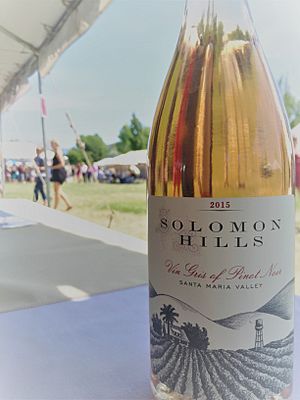Santa Maria Valley AVA facts for kids
| Wine region | |
| Type | American Viticultural Area |
|---|---|
| Year established | 1981, amended 1985 |
| Country | United States |
| Part of | Central Coast AVA, California |
| Climate region | Region I |
| Total area | 98,790 acres (40,000 ha) |
| Size of planted vineyards | 7,500 acres (3,000 ha) |
| Grapes produced | Aligote, Cabernet Sauvignon, Chardonnay, Chenin blanc, Grenache, Malbec, Marsanne, Merlot, Mondeuse, Nebbiolo, Petit Verdot, Pinot blanc, Pinot gris, Pinot noir, Riesling, Roussanne, Sangiovese, Sauvignon blanc, Silvaner, Syrah, Tocai Friulano, Viognier, Zinfandel |
The Santa Maria Valley is a special farming area in California, United States. It's located in northern Santa Barbara County and San Luis Obispo County. This area is known for growing grapes that are used to make different kinds of products. It's officially recognized as an American Viticultural Area, or AVA, which means it has unique features that make it great for growing grapes.
Contents
History of Grape Growing
This area has the oldest history of grape growing in its part of California. People started growing grapes here way back in the 1830s, during the time when Mexico controlled California.
Later, in the late 1960s, large farms started planting grapes to supply businesses all over the state. Since then, the grape farms in the valley have grown a lot. Today, they cover about 7,500 acres (3,000 ha) of land.
Geography of the Valley
The Santa Maria Valley is shaped like a natural funnel. It opens up towards the west, leading right to the Pacific Ocean.
The land in this area goes from about 200 feet (60 m) high near the Santa Maria River to about 3,200 feet (980 m) at Tepusquet Peak. The grapes are grown on the flat valley floor, which is about 300 feet (90 m) high. They also grow on the gentle slopes and rolling hills, up to about 800 feet (240 m) in elevation.
The soil in the valley is good for growing grapes. It ranges from sandy soil to a mix of sand and clay. This soil is also free from harmful salts.
Climate for Grapes
Because the valley opens to the ocean, cool sea fog can easily roll in overnight. This fog often covers the lower grape farms and can stay until midday. This makes the area a cool place for grapes to grow. It's known as a "Region I" on the Winkler Scale, which is a way to measure how warm a grape-growing area is.
The valley has a very long growing season, which means the grapes have lots of time to develop their flavors on the vine. It also gets very little rainfall, which is important for controlling how much water the grapes receive.
| Monthly normal and record high and low temperatures | ||||||||||||
| Month | Jan | Feb | Mar | Apr | May | Jun | Jul | Aug | Sep | Oct | Nov | Dec |
|---|---|---|---|---|---|---|---|---|---|---|---|---|
| Rec high °F | 86 | 89 | 95 | 103 | 100 | 102 | 104 | 103 | 103 | 108 | 93 | 90 |
| Norm high °F | 63.9 | 64.8 | 64.8 | 67.6 | 68.6 | 71.4 | 73.5 | 74.2 | 74.9 | 74 | 69.2 | 64.9 |
| Norm low °F | 39.3 | 41.4 | 42.7 | 43.4 | 46.9 | 50.4 | 53.5 | 54.2 | 52.9 | 48.2 | 41.8 | 38.2 |
| Rec low °F | 5 | 22 | 24 | 31 | 31 | 36 | 43 | 43 | 36 | 26 | 25 | 20 |
| Precip (in) | 2.64 | 3.23 | 2.94 | 0.91 | 0.32 | 0.05 | 0.03 | 0.05 | 0.31 | 0.45 | 1.24 | 1.84 |
| Source: USTravelWeather.com [1] | ||||||||||||
Types of Grapes Grown
Because the Santa Maria Valley has such a cool climate for growing, it's especially good for certain types of grapes. The most famous grapes grown here are:
- Pinot noir
- Syrah
- Chardonnay
- Pinot blanc
Expanding the Grape Growing Area
On January 28, 2011, the southern edge of the Santa Maria Valley AVA was changed. This was done to make the boundary match the natural watershed of the Santa Maria River more closely. The new boundary now mostly follows the ridge of hills that separates the Santa Maria Valley from the Los Alamos Valley.
This change added a lot more land to the grape-growing area. It included an extra 18,790 acres and nine new grape farms!


